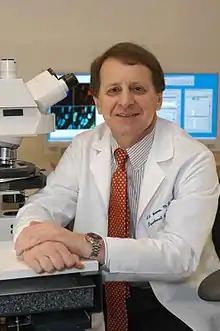Stephen Waxman
Stephen George Waxman (born 1945) is an American neurologist and neuroscientist.[1] He served as Chairman of the Department of Neurology at Yale Medical School, and Neurologist-in-Chief at Yale-New Haven Hospital from 1986 until 2009.[2] As of 2018, he is the Bridget Flaherty Professor of Neurology, Neurobiology, and Pharmacology at Yale University.[1] He founded the Yale University Neuroscience & Regeneration Research Center in 1988 and is its Director.[3] He previously held faculty positions at Harvard Medical School, MIT, and Stanford Medical School.[2][4] He is also visiting professor at University College London.[5]

Waxman has built on the "molecular revolution" to study, at a fundamental level, how neurons and glial cells work within the normal nervous system, and why they do not work properly in various diseased states. His laboratory studies isolated nerve cells in culture,[6] and rodents with experimental autoimmune encephalomyelitis, a model of multiple sclerosis.[7] These studies have, for example, provided a basis for a clinical trial of the efficacy of phenytoin, a sodium channel blocker in patients with optic neuritis.[8]
Waxman's studies have combined molecular genetics, molecular biology, and biophysics to show how specific ion channels relate to human pain.[9] He has been a member of an international coalition that showed that sodium channel mutations can cause of peripheral neuropathy.[10] He has used atomic-level modeling to study pharmacogenomics, at first in laboratory studies,[11] and then in early studies on genomically guided approaches to the treatment of pain.[12] A novel class of medications that target sodium channels in the peripheral nervous system, and that do not have potential for addiction, is based in part on his work and is currently being assessed in early-stage clinical trials.[13][14]
References
- "Stephen George Waxman, MD, PhD > Neurology | Yale School of Medicine". medicine.yale.edu. Retrieved 2018-03-22.
- G., Waxman, Stephen (2001). Form and function in the brain and spinal cord : perspectives of a neurologist. Cambridge, Mass.: MIT Press. ISBN 0262232103. OCLC 43362046.
- "Home > Center for Neuroscience and Regeneration Research | Yale School of Medicine". medicine.yale.edu. Retrieved 2018-03-22.
- "About | Neurosciences PhD Program | Stanford Medicine". med.stanford.edu. Retrieved 2018-03-22.
- "Stephen Waxman, MD, PhD | Yale and the World". world.yale.edu. Retrieved 2018-03-22.
- Stys, P. K.; Waxman, S. G.; Ransom, B. R. (February 1992). "Ionic mechanisms of anoxic injury in mammalian CNS white matter: role of Na+ channels and Na(+)-Ca2+ exchanger". The Journal of Neuroscience. 12 (2): 430–439. doi:10.1523/JNEUROSCI.12-02-00430.1992. ISSN 0270-6474. PMC 6575619. PMID 1311030.
- Lo, Albert C.; Saab, Carl Y.; Black, Joel A.; Waxman, Stephen G. (November 2003). "Phenytoin protects spinal cord axons and preserves axonal conduction and neurological function in a model of neuroinflammation in vivo". Journal of Neurophysiology. 90 (5): 3566–3571. doi:10.1152/jn.00434.2003. ISSN 0022-3077. PMID 12904334.
- Raftopoulos, Rhian; Hickman, Simon J.; Toosy, Ahmed; Sharrack, Basil; Mallik, Shahrukh; Paling, David; Altmann, Daniel R.; Yiannakas, Marios C.; Malladi, Prasad (March 2016). "Phenytoin for neuroprotection in patients with acute optic neuritis: a randomised, placebo-controlled, phase 2 trial". The Lancet. Neurology. 15 (3): 259–269. doi:10.1016/S1474-4422(16)00004-1. ISSN 1474-4465. PMID 26822749.
- Waxman, Stephen G.; Dib-Hajj, Sulayman (December 2005). "Erythermalgia: molecular basis for an inherited pain syndrome". Trends in Molecular Medicine. 11 (12): 555–562. doi:10.1016/j.molmed.2005.10.004. ISSN 1471-4914. PMID 16278094.
- Faber, Catharina G.; Lauria, Giuseppe; Merkies, Ingemar S. J.; Cheng, Xiaoyang; Han, Chongyang; Ahn, Hye-Sook; Persson, Anna-Karin; Hoeijmakers, Janneke G. J.; Gerrits, Monique M. (2012-11-20). "Gain-of-function Nav1.8 mutations in painful neuropathy". Proceedings of the National Academy of Sciences of the United States of America. 109 (47): 19444–19449. Bibcode:2012PNAS..10919444F. doi:10.1073/pnas.1216080109. PMC 3511073. PMID 23115331.
- Yang, Yang; Dib-Hajj, Sulayman D.; Zhang, Jian; Zhang, Yang; Tyrrell, Lynda; Estacion, Mark; Waxman, Stephen G. (2012). "Structural modelling and mutant cycle analysis predict pharmacoresponsiveness of a Na(V)1.7 mutant channel". Nature Communications. 3: 1186. Bibcode:2012NatCo...3.1186Y. doi:10.1038/ncomms2184. PMC 3530897. PMID 23149731.
- Geha, Paul; Yang, Yang; Estacion, Mark; Schulman, Betsy R.; Tokuno, Hajime; Apkarian, A. Vania; Dib-Hajj, Sulayman D.; Waxman, Stephen G. (2016-06-01). "Pharmacotherapy for Pain in a Family With Inherited Erythromelalgia Guided by Genomic Analysis and Functional Profiling". JAMA Neurology. 73 (6): 659–667. doi:10.1001/jamaneurol.2016.0389. ISSN 2168-6157. PMID 27088781.
- Cao, Lishuang; McDonnell, Aoibhinn; Nitzsche, Anja; Alexandrou, Aristos; Saintot, Pierre-Philippe; Loucif, Alexandre J. C.; Brown, Adam R.; Young, Gareth; Mis, Malgorzata (2016-04-20). "Pharmacological reversal of a pain phenotype in iPSC-derived sensory neurons and patients with inherited erythromelalgia" (PDF). Science Translational Medicine. 8 (335): 335ra56. doi:10.1126/scitranslmed.aad7653. ISSN 1946-6242. PMID 27099175. S2CID 39718489.
- Zakrzewska, Joanna M.; Palmer, Joanne; Morisset, Valerie; Giblin, Gerard Mp; Obermann, Mark; Ettlin, Dominik A.; Cruccu, Giorgio; Bendtsen, Lars; Estacion, Mark (April 2017). "Safety and efficacy of a Nav1.7 selective sodium channel blocker in patients with trigeminal neuralgia: a double-blind, placebo-controlled, randomised withdrawal phase 2a trial" (PDF). The Lancet. Neurology. 16 (4): 291–300. doi:10.1016/S1474-4422(17)30005-4. ISSN 1474-4465. PMID 28216232. S2CID 44910696.